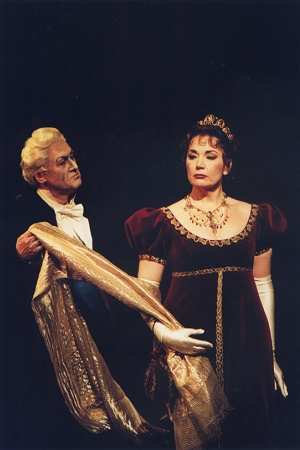|
<< -- 4 -- Roderic Dunnett Cosseted by Robespierre

Scarpia gets his chance in Act II (Read's rouged fireside lighting of
the huge room is even more of a triumph). Offstage flute and soft strings
create an artifically lulling mood; for Scarpia is in full plotting vein
-- outwardly proccupied with Cavaradossi, but inwardly fixated on Tosca.
Yet even her seduction (for which Cavaradossi is equally a tool to be disposed
of) is to be only en passant : 'Once I conceive a pleasure, I satisfy
it, and discard it.' Leiferkus's exchanges with his agent and confidant,
Spoletta (the seasoned Robin Leggate) were consistently and aptly unpleasant.
The obscene little juridical procession which precedes the torturing of
Cavaradossi is staged with a gleeful nastiness (how terrifying those words
'it is a loyal subject who accuses you' are : grim shades of Madame Defarge).
The start of the scene is all the more effective for Leiferkus and Pavarotti
singing restrainedly, enabling the sounds of Tosca's cantata to penetrate
from offstage. With López-Cobos nursing tenderly, there were lots
of wonderful little orchestral details : the cello sigh that precedes 'Where
is Angelotti?' Low flute (again) for the tense Tosca-Cavaradossi exchange;
oboe, clarinet and bass clarinet as sounds of the torture emerge; the little
march into which the orchestra breaks at Cavaradossi's Marengo outburst
'Victoria, victoria'; and dark paired flutes -- again shades of Pelléas
-- for Scarpia's outrageous proposal : 'It will be for some other payment'
('Già mi dicon venal').

Puccini's balancing of Act II, so subtly phased and graded, is too astonishingly
good to retail. But so too was Leiferkus's, right down to the little visual
Leitmotif of removing, and returning, Tosca's shawl. The act builds
inexorably to its centrepiece, Tosca's great aria 'Vissi d'arte', awesomely
prefaced by side drum, bassoon, brass, then paired clarinets, and superbly
delivered, with affectionate attendant strings, from rear stage by Vaness.
López-Cobos might have kept the string lament even softer (like the
wonderful pianissimo double bass pizzicato with which it concluded,
or the admirable quadruple piano achieved for Tosca and Cavaradossi,
so advantageous to the building drama of Act III). Puccini's plaint is of
extraordinary provenance -- the chords are in places identical with Hungarian
courtly 'recruiting' music.
Continue >>
Copyright © 17 January 2002
Roderic Dunnett, Coventry, UK
 LONDON'S ROYAL OPERA HOUSE WEBSITE
<< Music
& Vision home
Russian UK premières >>
LONDON'S ROYAL OPERA HOUSE WEBSITE
<< Music
& Vision home
Russian UK premières >>
|

